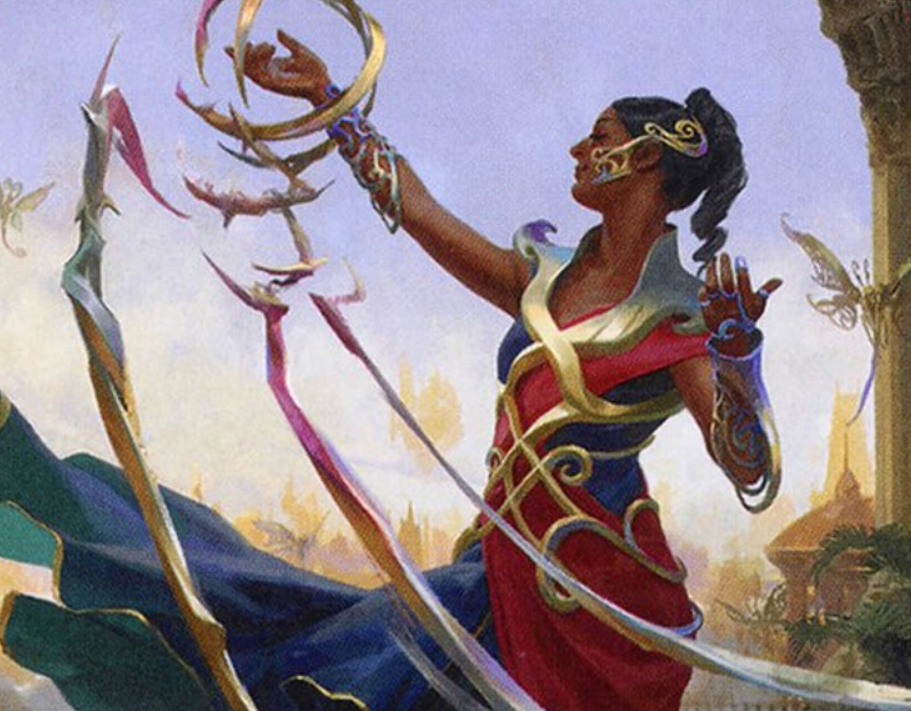Are you a Quiet Speculation member?
If not, now is a perfect time to join up! Our powerful tools, breaking-news analysis, and exclusive Discord channel will make sure you stay up to date and ahead of the curve.
Back in the Spring, I wrote a couple of articles that focused on sealed booster box prices. I focused mostly on the oldest products—sets that came out prior to 2000—and showcased just how expensive these have become over the years. Touching on this topic after ignoring sealed boxes for years really got me thinking.
A while back I had sworn off booster box investing for a number of reasons. The first and foremost reason I abandoned the strategy was opportunity cost. While singles were all soaring in price (particularly the Old School cards I had developed an affinity for), I felt sitting on a booster box for ten years in the hopes of turning $100 into $300 was not the best play. This was compounded by the fact that boxes took up more space, were more costly to ship, and were much slower to sell.
Some of these variables have changed enough lately to cause me to reconsider this space. In fact, I’ve already made a few booster box purchases last week as a way of getting back in. This week I’ll cover four reasons I am examining sealed booster boxes as investments once again, and I’ll touch on which boxes, in particular, have caught my eye so far.
Reason #1: Sealed Product Still Appreciates
One reason I originally abandoned booster box investments was the skyrocketing print runs associated so that Wizards could meet the demands of their ever-growing player base. I interpreted this trend to mean that the days of the $500+ booster boxes may be stuck relegated to sets printed before 2010. I was particularly burnt on Return to Ravnica and Magic Origins, which I purchased in disproportional quantity only to see their values rot.
In fact, sealed boxes of these sets can still be had for $138 and $145, respectively, even today.
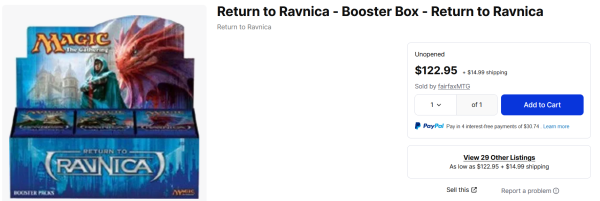
Consider: Return to Ravnica turns ten this October, yet box values have only really appreciated about 30% in that time frame. Recent recession fears aside, this doesn’t even beat the return of the S&P 500 over that timeframe. I was smart to sell out of all those RTR boxes when I did.
Wait a second… doesn’t this undermine the point I was trying to make in this article? Well, it turns out Return to Ravnica was a particularly poor choice for box investment. One of the worst, in fact. Booster boxes from more recent sets have done far better. Consider Kaladesh and Khans of Tarkir, for example, which came out in 2016 and 2014, respectively.
The former’s booster boxes sell for over $400 and the latter’s are around $230.
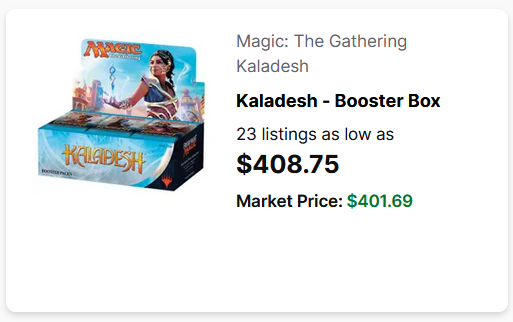
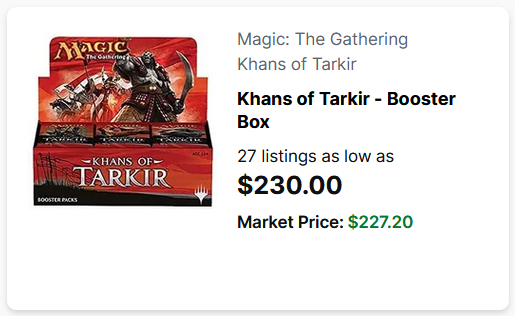
If I had been picking up cases of these sets instead of Return to Ravnica, I would have done much better in my investment. Thus, I will not let a couple of poor choices deter me from making another go at sealed product.
Reason #2: Shifted Priorities
The last time I attempted to speculate on sealed product, I would find myself sitting in my basement and thinking of all the value I had stuck in these boxes. In my mind, those were dollars that could have been used to improve my decks and expand my Old School collection. It was beginning to feel like I was wasting resources by waiting for an extremely slow booster box appreciation process. I needed cards and I needed them right away!
Thus, after selling out of my sealed inventory I quickly put that money to work elsewhere. This helped me build up my collection to what it has become, and I have no regrets about this decision.
Fast forward to today, however, and my sentiments have changed. I haven’t found myself really wanting another Old School card in months. It’s not that I’ve lost interest—instead, I am simply content with the cards I have in my collection currently. Of course, I wouldn’t turn down a great deal on a card that’s currently absent from my collection, nor would I ignore a deeply discounted Shahrazad.
On the other hand, the fact that most of my gameplay nowadays takes place on Arena means I have little need to purchase more singles for my collection. As cash sits idle in my Magic account, I can’t help but wonder if there’s a better place to put my resources. The stock market seems precarious at the moment, and I am not really of the mind to purchase surplus Old School cards strictly for investment purposes—if I won’t appreciate the card in my collection, I’d just as soon sell it.
Thus, booster boxes suddenly become an attractive option because I can park money there for a slow, steady return. These also make nice display pieces on my shelf, which I do appreciate.
Reason 3: Planning for a Rainy Day
Arena has reminded me just how much I enjoy Limited play. Now that the Historic format has gotten stale (in my opinion), I’ve shifted my gameplay time back to Draft and Sealed events on the digital platform. Being able to play Limited with the newest sets for free is an extremely attractive notion.
This re-engagement with Limited play reminded me how much I used to have fun drafting paper Magic. Granted, I must face facts: I don’t have seven Magic playing friends, nor do I have much opportunity to draft paper Magic these days. However, there is hope ahead. My son is now ten years old and has expressed interest in the game. Perhaps in just a few years, the two of us can start attending FNMs and larger events together.
As he gets older, and if he maintains an interest in Magic, I’ll want to have some sealed product on hand with the promise of one day enjoying them. What’s more, I’ve always enjoyed the notion of opening older sets, so sitting on sealed product for a few years will be the best and most affordable way to accomplish this objective. Lastly, for the very long-term view, having some sealed boxes many years from now—perhaps after paper Magic eventually sunsets—will be something to cherish.
Reason 4: Another Reason to Shop for Deals
I experience a sort of thrill when shopping for deals. When I can find a Magic card I want with a price that’s discounted to the rest of the market, it gives me a very small hit of dopamine. To me, it’s akin to winning $4 on that $1 scratch-off ticket. The amount isn’t life-changing in any way, but the idea that I won something that is not easy to win gives me a temporary warm and fuzzy feeling.
My recent disinterest in acquiring new singles, however, has unintentionally diminished this feeling. If I’m not actively looking for cards to add to my decks or collection, then I’m not shopping for deals nearly as much. This apathy could lead to a larger disinterest in Magic—something I want to avoid as I still enjoy the game overall and I want to make sure I still have new topics to write about for this website!
Enter: sealed product.
Even if my seedling interest in buying sealed product is minuscule, I still want to water it and foster it so that it grows into something meaningful. This way my interest in the game continues and I maintain some involvement. Plus, as a critical bonus, I get to experience more dopamine hits as I once again can shop for deals!
What kind of deals? Last week I purchased a few booster boxes for what looked like the best prices I could find. I bought two different boxes directly from Star City Games: one box of Ixalan and one of Battle for Zendikar. The former cost me $151.59 and the latter was $199.09. How does this compare to TCGplayer?
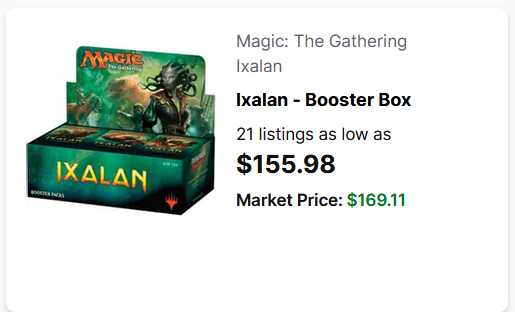
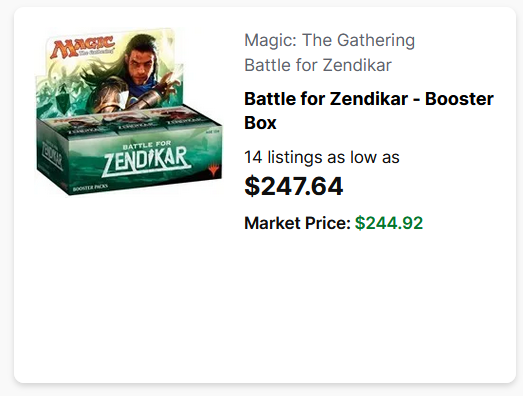
I was especially excited to grab that BFZ box—Battle for Zendikar has Expeditions, making the set attractive for the long term. The fact that there are only 14 listings on TCGplayer tells me that supply has really thinned out, meaning there could be some sizable upside in the next few years. While Ixalan didn’t resonate with me nearly as much, there are only 21 listings on TCGplayer, which is also surprisingly low. Anytime a booster box’s TCGplayer inventory dips into 20s of listings, I see that as a good sign for growth ahead.
Besides these two boxes, I also recently purchased booster boxes of Unstable, Aether Revolt, and War of the Spark. Unstable was an impulse purchase because I enjoy the Un-sets, Aether Revolt felt like a discounted Kaladesh with Masterpiece potential, and War of the Spark interested me for all its planeswalkers.
These sets are all newer than Return to Ravnica, but their boxes have already appreciated more than RTR’s. This gives me confidence that these will be winners, unlike RTR, and therefore offer greater upside potential.
Wrapping It Up
Before anyone asks, I’m not going extremely deep on these booster boxes. If anything, I’m going to aim for some breadth and diversification rather than attempting to go deep on any one set. This spreads out my risk, expands my options for Limited play in the future, and makes for a more interesting display on my basement shelf.
In the coming weeks, I plan to hunt and shop for a couple more boxes—I’m interested in picking up a booster box of Dominaria in preparation for the coming release of Dominaria United. When Unfinity is released, I may pick up a couple of those as well—one to open immediately with my son and one or two to sit on for a rainy day.
That’ll probably be about it for the short term. Sure, I’d absolutely love to pick up some boxes of older sets—sets from before 2010 or even 2000. But those are so expensive nowadays that the cost has really become prohibitive. I absolutely loved Time Spiral block, for example, but I have no interest in dropping a couple thousand dollars to relive the paper draft experience of that set.
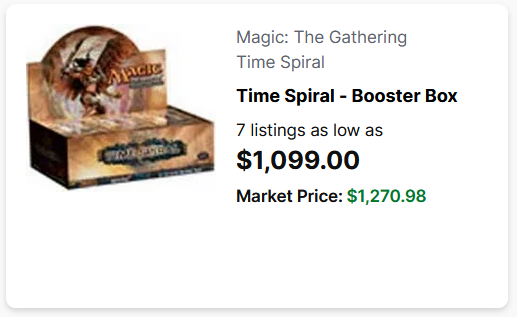
Looking at these exorbitant prices really has me regretting that I abandoned my sealed booster box investment of a decade ago. There’s no sense in regretting past decisions, however. The best I can do is learn from it and move on, and that’s precisely what I’m doing now. Sealed booster boxes can still be viable investments or storages of value, and I hope to leverage the new generation of sets to some success in the years to come.


